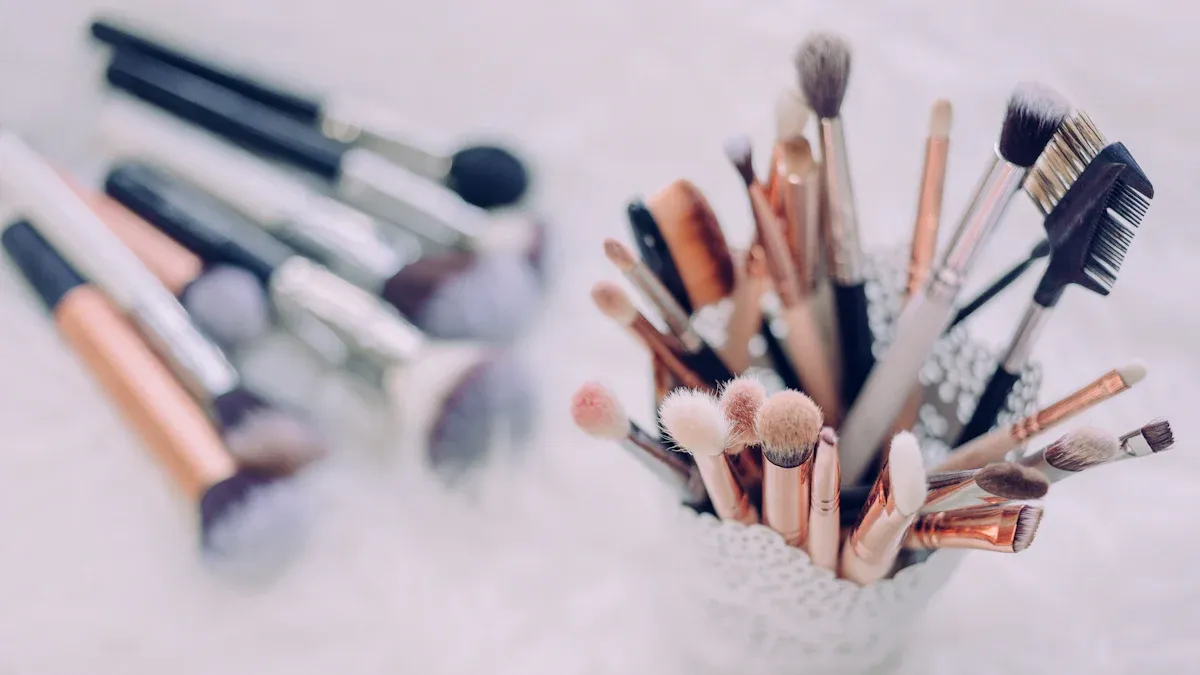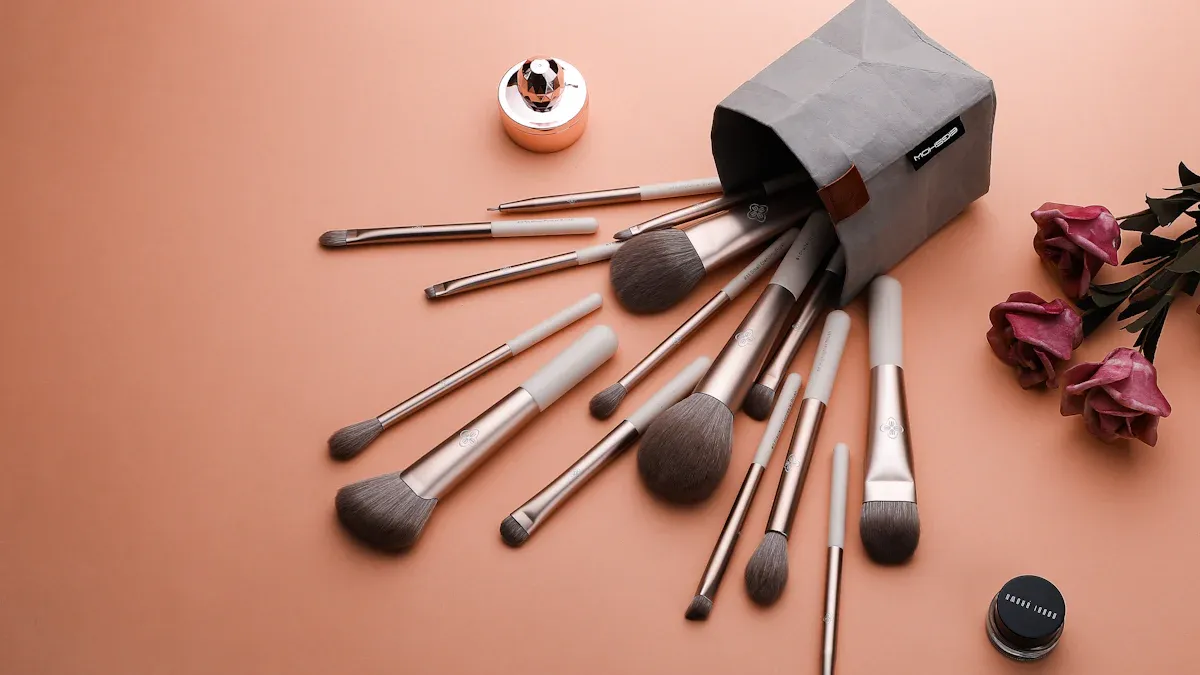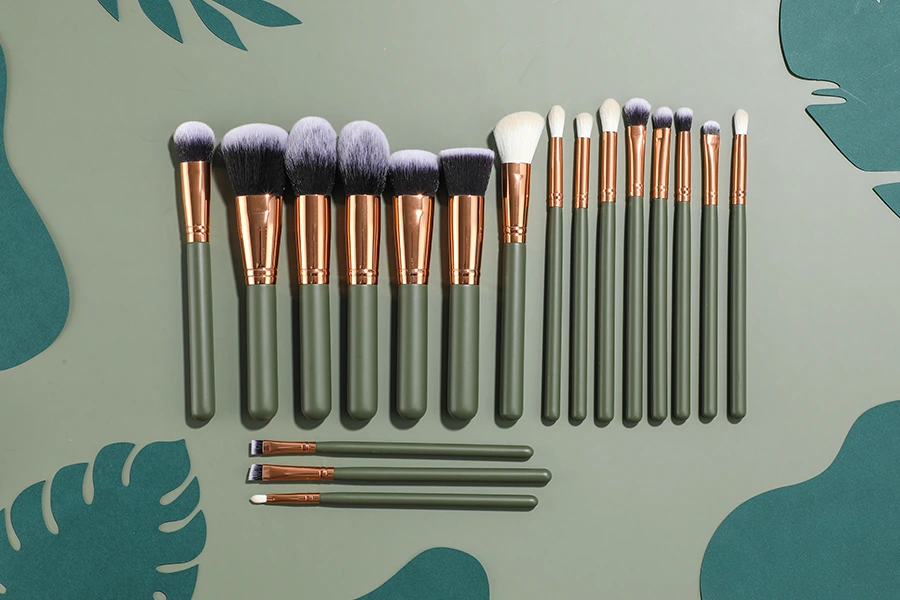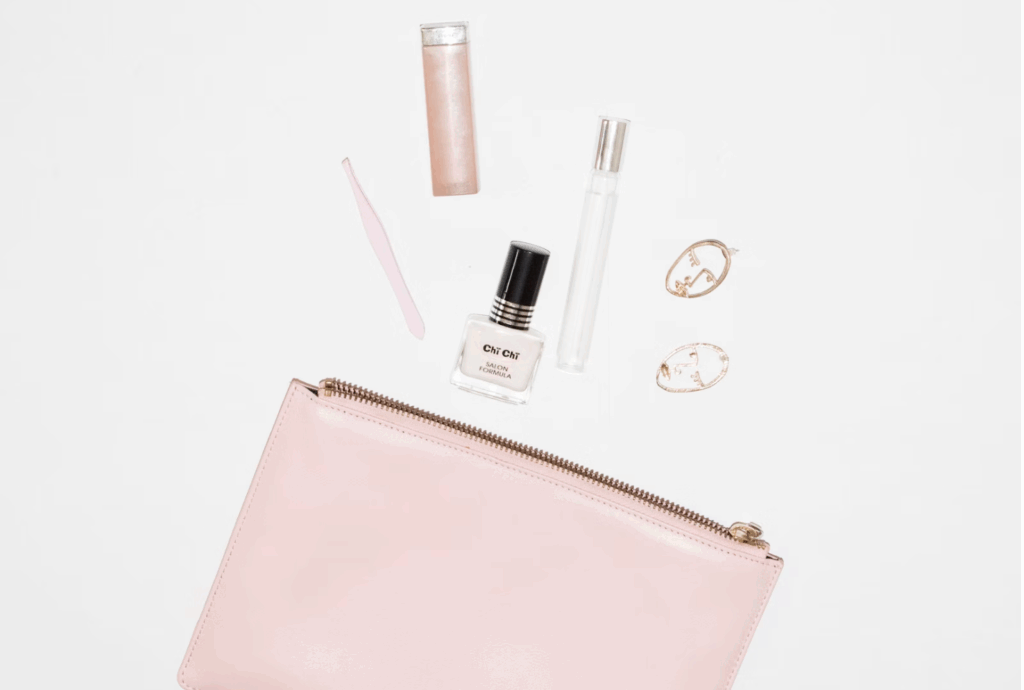
You want your makeup to look smooth and natural. The kabuki brush helps you get full, même la couverture, especially with powders or mineral products. Some makeup brushes work better for small areas or liquid products. Think about how much coverage you want and what products you use most. Your brush choice affects how well you can blend and finish your look. Your skin type and daily routine also matter when picking the right tool.
Qu'est-ce qu'un pinceau Kabuki?

Key Features of Kabuki Brushes
UN pinceau kabuki stands out because of its unique design. You will notice its short handle and dense, soft bristles. This shape comes from Japanese Kabuki theater, where actors used it to create bold, flawless makeup. Aujourd'hui, you can find different types of kabuki brushes, such as flat, dôme, and angled shapes. Each style helps you apply makeup in a specific way. Par exemple, a dome-shaped kabuki brush works well for blending powder across your face. Some modern brushes use synthetic fibers, which make them great for both powder and liquid products. The sturdy handle gives you control, so you can blend makeup smoothly.
Benefits of Using a Kabuki Brush
You get many benefits and limitations when you use a pinceau kabuki. The dense bristles pick up a lot of product, so you can cover your face quickly. You will see even coverage without streaks or caking. This brush works well for setting your foundation with powder, blending blush, or adding bronzer. You can also use it for body makeup, like applying shimmer or self-tanner. The soft bristles feel gentle on your skin, which helps if you have sensitive skin. You will also find that a kabuki brush makes it easy to build up coverage, so you can choose a natural or full look. Souviens-toi, every tool has benefits and limitations, so think about what you want from your makeup routine.
When to Use a Kabuki Brush
You should reach for a kabuki brush when you want to apply powder foundation, rougir, or setting powder. The brush’s dense bristles help you blend products evenly across your face. Use a kabuki brush for setting your makeup, especially if you want a smooth, finition aérographe. You can also use it for contouring by choosing a flat or angled style. Some people use kabuki brushes for liquid or cream products, but synthetic bristles work best for this. Try using a kabuki brush for quick touch-ups or when you need to blend makeup on your neck and body. Always clean your brush every week to keep it working well and to avoid buildup. Knowing the benefits and limitations of each brush helps you decide when to use it for the best results.
Overview of Other Makeup Brushes

Pinceaux en poudre
Powder brushes are important if you want a soft look. These brushes have fluffy bristles that are not packed tightly. This makes it easy to sweep powder on your face. Some powder brushes use synthetic bristles, while others use natural ones. Synthetic bristles last long and are simple to clean. Natural bristles feel soft and spread powder well. Powder brushes come in shapes like fan, tapered, or round. Each shape helps you put on makeup in a special way. A fan brush gives a light touch of highlighter. A round brush blends powder for a smooth finish.
Note: You can now buy powder brushes with eco-friendly handles and vegan bristles. These are good choices if you care about the planet.
Powder brushes come in many prices. Expensive brushes last longer and work better. Professionals like luxury brushes for their quality. If you want a brush for both loose and pressed powders, get a powder brush for your kit.
Foundation Brushes
UN pinceau à fond de teint helps you put on foundation smoothly. You can use it for liquid or cream foundation. Most foundation brushes have dense, soft bristles for blending. Some popular styles are flat-top, rounded, and slanted brushes. Each style gives a different finish. A flat-top brush buffs foundation for a flawless look.
A good foundation brush makes makeup easier and saves product. Most makeup kits include a foundation brush because it is useful.
Blush and Contour Brushes
Blush and contour brushes help you add color and shape. These brushes come in shapes like angled, tapered, or dome. An angled brush helps you shape your cheekbones. A dome brush blends blush for a soft glow. Many brushes use soft synthetic bristles for powders and creams.
You can use these brushes for natural or bold styles. Many people like soft bristles to avoid skin problems. The right blush and contour brushes give you more control and a pro finish. These tools help you get the look you want easily.
Fan Brushes and Detail Brushes
Fan brushes and detail brushes help you put on makeup with care. Fan brushes have a wide, flat shape like a fan. You can use them to add highlighter to your cheekbones or brush away extra powder. The fan shape helps you blend bronzer or blush for a soft look. Fan brushes are best when you want a light touch and a natural finish.
Fan brushes are great for blending and softening color. You can use them to smooth out harsh lines or add a little shimmer. Detail brushes help you work on small, careful spots. Both brushes help you finish your makeup and look polished.
How to Choose the Right Brush for You
A recent survey shows that 58% of people use all their brushes regularly, but 30% stick to just a few favorites. This means your makeup goals play a big part in choosing the right brush for your routine.
Match to Your Skin Type and Products
Your skin type and the products you use matter when choosing the right brush. If you have oily skin or use liquid foundation, synthetic brushes work well because they do not soak up too much product. People with dry or sensitive skin often prefer natural bristles, which feel soft and blend powders gently.
Dermatology studies show that matching your brush to your skin type and product can improve your skin’s appearance. Par exemple, using a brush designed for acne-prone skin with the right cleanser can help clear up breakouts. Always check if your brush works well with your favorite makeup products.
Assess Your Daily Routine and Skill Level
Your daily routine and skill level also guide you in choosing the right brush. If you do quick makeup each morning, you may only need a few basic brushes. A kabuki brush or a powder brush can cover most needs. If you enjoy trying new looks or use many products, you might want a full set of makeup brushes.
You make smart choices when you plan your budget and care for your brushes. Brands use strong research and expert advice to design products that fit your needs and last longer. This helps you get the most out of your investment and enjoy flawless makeup every day.
Tips for Getting the Best Results
Cleaning and Caring for Your Brushes
You want your makeup brushes to last and keep your skin healthy. Clean your brushes at least once a week. Dermatologists and makeup professionals agree that regular cleaning stops bacteria, huile, and old makeup from building up. Dirty brushes can cause acne and skin irritation. If you use brushes for liquid or cream products, wash them after every use. This keeps germs away, especially around your eyes.
Follow these steps for best results:
Set a weekly cleaning routine. Clean more often if you use your brushes every day.
Use gentle soap or a special brush cleanser. Swirl the bristles in the cleanser, rinse well, and reshape the brush.
Lay brushes flat or at a slight angle to dry. This stops water from getting into the handle and damaging the brush.
Store brushes upright in a holder. Keep them away from dust, sunlight, and humidity.
Check your brushes for fraying or shedding. Replace them if they lose their shape or softness.
Application Tips for Different Brushes
You can get the best makeup results by using the right brush for each job. Experts recommend different brushes for different tasks:
You have many choices when it comes to makeup brushes. Each brush gives you a different result. Some brushes help you get light coverage, while others help you blend for a smooth finish. Think about your skin, your favorite products, and your daily routine. Try different brushes to see what works best for you. You can find the right tools to match your style and needs.
FAQ
What makes a kabuki brush different from other makeup brushes?
A kabuki brush has dense, soft bristles and a short handle. You use it for even, full coverage with powder products. Other brushes often have longer handles and less dense bristles, which give you lighter coverage.
Can you use a kabuki brush with liquid foundation?
Oui, you can use a kabuki brush with liquid foundation, especially if it has synthetic bristles. You get smooth blending and buildable coverage. Always clean your brush after using it with liquids.
À quelle fréquence devez-vous nettoyer vos pinceaux de maquillage?
You should clean your makeup brushes once a week. If you use them with liquid or cream products, wash them after each use. Clean brushes help keep your skin healthy and your makeup looking fresh.
Which brush is best for beginners?
A kabuki brush works well for beginners. You can use it for many products, like powder, rougir, or bronzer. Its dense bristles make blending easy. You get a smooth, even finish without much effort.
Conseil: Try a starter brush set if you want to explore different brush types.


















